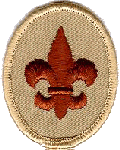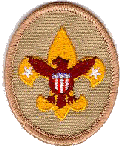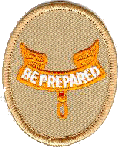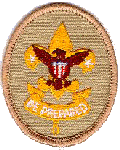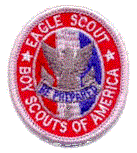- Scouts
- Repeat from memory the Scout Oath, Scout Law, Scout motto, and Scout slogan. In your own words, explain their meaning.
- Explain what Scout spirit is. Describe some ways you have shown Scout spirit by practicing the Scout Oath, Scout Law, Scout motto, and Scout slogan.
- Demonstrate the Boy Scout sign, salute, and handshake. Explain when they should be used.
- Describe the First Class Scout badge and tell what each part stands for. Explain the significance of the First Class Scout badge.
- Repeat from memory the Outdoor Code. In your own words, explain what the Outdoor Code means to you.
- Repeat from memory the Pledge of Allegiance. In your own words, explain its meaning.
- After attending at least one Boy Scout troop meeting, do the following:
- Describe how the Scouts in the troop[1] provide its leadership.
- Describe the four steps of Boy Scout advancement.
- Describe the Boy Scout ranks and how they are earned.
- Describe what merit badges are and how they are earned.
- Patrol
- Explain the patrol method. Describe the types of patrols that are used in your troop.
- Become familiar with your patrol name, emblem, flag, and yell. Explain how these items create patrol spirit.
- Knots & ropes
- Show how to tie a square knot, two half-hitches, and a taut-line hitch. Explain how each knot is used.
- Show the proper care of a rope by learning how to whip and fuse the ends of different kinds of rope.
- Demonstrate your knowledge of pocketknife safety.
- With your parent or guardian, complete the exercises in the pamphlet How to Protect Your Children from Child Abuse: A Parent’s Guide and earn the Cyber Chip Award for your grade.[2]
- Since joining the troop[1] and while working on Scout rank, participate in a Scoutmaster conference.
NOTE: These requirements may be worked on simultaneously with those for Second Class and First Class; however these ranks must be earned in sequence.
- Present yourself to your leader, properly dressed, before going on an overnight camping trip. Show the camping gear you will use. Show the right way to pack and carry it.
- Spend at least one night on a patrol or troop campout. Sleep in a tent you have helped pitch.
- On the campout, assist in preparing and cooking one of your patrol's meals. Tell why it is important for each patrol member to share in meal preparation and cleanup, and explain the importance of eating together.
- Demonstrate how to whip and fuse the ends of a rope.
- Demonstrate you know how to tie the following knots and tell what their uses are: two half hitches and the taut-line hitch.
- Explain the rules of safe hiking, both on the highway and cross-country, during the day and at night. Explain what to do if you are lost.
- Demonstrate how to display, raise, lower, and fold the American flag.
- Repeat from memory and explain in your own words the Scout Oath, Law, motto, and slogan.
- Know your patrol name, give the patrol yell, and describe your patrol flag.
- Explain why we use the buddy system in Scouting.
- Explain the importance of the buddy system as it relates to your personal safety on outings and in your neighborhood. Describe what a bully is and how you should respond to one.
- Record your best in the following tests:
- Push-ups
- Pull-ups
- Sit-ups
- Standing long jump
- 1/4 mile walk/run
- Show improvement in the activities listed in requirement 10a after practicing for 30 days.
- Record your best in the following tests:
- Identify local poisonous plants; tell how to treat for exposure to them.
- Demonstrate how to care for someone who is choking.
- Show first aid for the following:
- Simple cuts and scratches
- Blisters on the hand and foot
- Minor burns or scalds (first degree)
- Bites and stings of insects and ticks
- Poisonous snakebite
- Nosebleed
- Frostbite and sunburn
- Demonstrate scout spirit by living the Scout Oath (Promise) and Scout Law in your everyday life.
- Participate in a Scoutmaster conference. Request a conference
- Complete your board of review
NOTE: Alternate Requirements for the Tenderfoot rank are available for Scouts with physical or mental disabilities if they meet the criteria listed in the Boy Scout Requirements book. (No. 33215F)
NOTE: These requirements may be worked on simultaneously with those for the Tenderfoot and First Class ranks; however these ranks must be earned in sequence.
- Demonstrate how a compass works and how to orient a map. Explain what map symbols mean.
- Using a compass and a map together, take a 5-mile hike (or 10 miles by bike) approved by your adult leader and your parent or guardian.*
- Since joining, have participated in five separate troop/patrol activities (other than troop/patrol meetings), two of which included camping overnight.
- On one of these campouts, select your patrol site and sleep in a tent that you pitched.
- On one campout, demonstrate proper care, sharpening, and use of the knife, saw, and ax, and describe when they should be used.
- Use the tools listed in requirement 2c to prepare tinder, kindling, and fuel for a cooking fire.
- Discuss when it is appropriate to use a cooking fire and a lightweight stove. Discuss the safety procedures for using both.
- Demonstrate how to light a fire and a lightweight stove.
- On one campout, plan and cook over an open fire one hot breakfast or lunch for yourself, selecting foods from the food pyramid. Explain the importance of good nutrition. Tell how to transport, store, and prepare the foods you selected.
- Participate in a flag ceremony for your school, religious institution, chartered organization, community, or troop activity.
- Participate in an approved (minimum of one hour) service project.
- Identify or show evidence of at least ten kinds of wild animals (birds, mammals, reptiles, fish, mollusks) found in your community.
- Show what to do for "hurry" cases of stopped breathing, serious bleeding, and internal poisoning.
- Prepare a personal first aid kit to take with you on a hike.
- Demonstrate first aid for the following:
- Object in the eye
- Bite of a suspected rabid animal
- Puncture wounds from a splinter, nail, and fishhook
- Serious burns (second degree)
- Heat exhaustion
- Shock
- Heatstroke, dehydration, hypothermia, and hyperventilation
- Tell what precautions must be taken for a safe swim.
- Demonstrate your ability to jump feetfirst into water over your head in depth, level off and swim 25 feet on the surface, stop, turn sharply, resume swimming, then return to your starting place.
- Demonstrate water rescue methods by reaching with your arm or leg, by reaching with a suitable object, and by throwing lines and objects. Explain why swimming rescues should not be attempted when a reaching or throwing rescue is possible, and explain why and how a rescue swimmer should avoid contact with the victim.
- Participate in a school, community, or troop program on the dangers of using drugs, alcohol, and tobacco, and other practices that could be harmful to your health. Discuss your participation in the program with your family.
- Explain the three R's of personal safety and protection
- Demonstrate scout spirit by living the Scout Oath (Promise) and Scout Law in your everyday life.
- Participate in a Scoutmaster conference.Request a conference
- Complete your board of review.
NOTE: These requirements may be worked on simultaneously with those for the Tenderfoot and First Class ranks; however these ranks must be earned in sequence.
- Since joining Scouts BSA, participate in 10 separate troop/patrol activities, at least six of which must be held outdoors. Of the outdoor activities, at least three must include overnight camping. These activities do not include troop or patrol meetings. On campouts, spend the night in a tent that you pitch or other structure that you help erect, such as a lean-to, snow cave, or tepee.
- Explain the potential impacts of camping, both on the environment and on other outdoor users. Explain why the Outdoor Code and Leave No Trace Seven Principles are important for protecting the outdoors.
- Help plan a menu for one of the above campouts that includes at least one breakfast, one lunch, and one dinner, and that requires cooking at least two of the meals. Tell how the menu includes the foods from MyPlate or the current USDA nutritional model and how it meets nutritional needs for the planned activity or campout.
- Using the menu planned in First Class requirement 2a, Make a list showing a budget and the food amounts needed to feed three or more youth. Secure the ingredients.
- Show which pans, utensils, and other gear will be needed to cook and serve these meals.
- Demonstrate the procedures to follow in the safe handling and storage of fresh meats, dairy products, eggs, vegetables, and other perishable food products. Show how to properly dispose of camp garbage, cans, plastic containers, waste water, and other rubbish.
- On one campout, serve as cook. Supervise your assistant(s) in using a stove or building a cooking fire. Prepare the breakfast, lunch, and dinner planned in First Class requirement 2a. Supervise the cleanup.
- Discuss when you should and should not use lashings.
- Demonstrate tying the timber hitch and clove hitch.
- Demonstrate tying the square, shear, and diagonal lashings by joining two or more poles or staves together.
- Use lashings to make a useful camp gadget or structure.
- Using a map and compass, complete an orienteering course that covers at least one mile and requires measuring the height and/or width of designated items (tree, tower, canyon, ditch, etc.).
- Demonstrate how to use a handheld GPS unit, GPS app on a smartphone, or other electronic navigation system. Use GPS to find your current location, a destination of your choice, and the route you will take to get there. Follow that route to arrive at your destination.
- Identify or show evidence of at least 10 kinds of native plants found in your local area or campsite location. You may show evidence by identifying fallen leaves or fallen fruit that you find in the field, or as part of a collection you have made, or by photographs you have taken.
- Identify two ways to obtain a weather forecast for an upcoming activity. Explain why weather forecasts are important when planning for an event.
- Describe at least three natural indicators of impending hazardous weather, the potential dangerous events that might result from such weather conditions, and the appropriate actions to take.
- Describe extreme weather conditions you might encounter in the outdoors in your local geographic area. Discuss how you would determine ahead of time the potential risk of these types of weather dangers, alternative planning considerations to avoid such risks, and how you would prepare for and respond to those weather conditions.
- Successfully complete the BSA swimmer test.
- Tell what precautions must be taken for a safe trip afloat. Identify the basic parts of a canoe, kayak, or other boat. Identify the parts of a paddle or an oar.
- Describe proper body positioning in a watercraft, depending on the type and size of the vessel. Explain the importance of proper body position in the boat.
- With a helper and a practice victim, show a line rescue both as tender and as rescuer. (The practice victim should be approximately 30 feet from shore in deep water.)
- Demonstrate bandages for a sprained ankle and for injuries on the head, the upper arm, and the collarbone.
- By yourself and with a partner, show how to:
- Transport a person from a smoke-filled room.
- Transport for at least 25 yards a person with a sprained ankle.
- Tell the five most common signals of a heart attack. Explain the steps (procedures) in cardiopulmonary resuscitation (CPR).
- Tell what utility services exist in your home or meeting place. Describe potential hazards associated with these utilities and tell how to respond in emergency situations.
- Develop an emergency action plan for your home that includes what to do in case of fire, storm, power outage, and water outage.
- Explain how to obtain potable water in an emergency.
- After completing Second Class requirement 7a, be physically active at least 30 minutes each day for five days a week for four weeks. Keep track of your activities.
- Share your challenges and successes in completing First Class requirement 8a. Set a goal for continuing to include physical activity as part of your daily life.
- Visit and discuss with a selected individual approved by your leader (for example, an elected official, judge, attorney, civil servant, principal, or teacher) the constitutional rights and obligations of a U.S. citizen.
- Investigate an environmental issue affecting your community. Share what you learned about that issue with your patrol or troop. Tell what, if anything, could be done by you or your community to address the concern.
- On a Scouting or family outing, take note of the trash and garbage you produce. Before your next similar outing, decide how you can reduce, recycle, or repurpose what you take on that outing, and then put those plans into action. Compare your results.
- Participate in three hours of service through one or more service projects approved by your Scoutmaster. The project(s) must not be the same service project(s) used for Tenderfoot requirement 7b and Second Class requirement 8e. Explain how your service to others relates to the Scout Law.
- Tell someone who is eligible to join Scouts BSA, or an inactive Scout, about your Scouting activities. Invite this person to an outing, activity, service project, or meeting. Provide information on how to join, or encourage the inactive Scout to become active. Share your efforts with your Scoutmaster or other adult leader.
- Demonstrate Scout spirit by living the Scout Oath and Scout Law. Tell how you have done your duty to God and how you have lived four different points of the Scout Law (different from those points used for previous ranks) in your everyday life.
- While working toward the First Class rank, and after completing Second Class requirement 11, participate in a Scoutmaster conference.
- Successfully complete your board of review for the First Class rank.
- Be active in your troop and patrol for at least 4 months as a First Class Scout.
- Demonstrate scout spirit by living the Scout Oath (Promise) and Scout Law in your everyday life.
- Earn 6 merit badges, including 4 from
the required list for Eagle.*
___________________________________(required for Eagle)*
___________________________________(required for Eagle)*
___________________________________(required for Eagle)*
___________________________________(required for Eagle)*
____________________________________________________
____________________________________________________ - While a First Class Scout, take part in service projects totaling at least 6 hours of work. These projects must be approved by your Scoutmaster.
- While a First Class Scout, serve actively 4
months in one or more of the following positions of responsibility (or
carry out a Scoutmaster-assigned leadership project to help the troop):
Boy Scout troop - Patrol leader
- assistant senior patrol leader
- senior patrol leader
- troop guide
- Order of the Arrow troop representative
- den chief,
- scribe
- librarian
- historian
- quartermaster
- bugler
- junior assistant Scoutmaster
- chaplain aide
- instructor
- Take part in a Scoutmaster conference Request a conference
- Complete your board of review.
* A Scout may choose any of the 15 required merit badges in the 12 categories to fulfill requirement 3.
- Be active in your troop and patrol for at least 6 months as a Star Scout.
- Demonstrate Scout spirit by living the Scout Oath (Promise) and Scout Law in your everyday life.
- Earn 5 more merit badges (so that you have 11 in all), including any
3 more from the required list for
Eagle.
___________________________________(required for Eagle)*
___________________________________(required for Eagle)*
___________________________________(required for Eagle)*
____________________________________________________
____________________________________________________ - While a Star Scout, take part in service projects totaling at least 6 hours of work. These projects must be approved by your Scoutmaster.
- While a Star Scout, serve actively 6 months in one or more of the positions of responsibility listed in requirement 5 for Star Scout (or carry out a Scoutmaster-assigned leadership project to help the troop).
- Take part in a Scoutmaster conference. Request a conference
- Complete your board of review.
* A Scout may choose any of the 15 required merit badges in the 12 categories to fulfill requirement 3.
- Be active in your troop and patrol for at least 6 months as a Life Scout.
- Demonstrate Scout spirit by living the Scout Oath (Promise) and Scout Law in your everyday life.
- Earn a total of 21 merit badges (10 more than you already have),
including the following:
- First Aid
- Citizenship in the Community
- Citizenship in the Nation
- Citizenship in the World
- Communications
- Personal Fitness
- Emergency Preparedness OR Lifesaving
- Environmental Science OR Sustainability
- Personal Management
- Swimming OR Hiking OR Cycling
- Camping
- Family Life *
- Cooking
- While a Life Scout, serve actively for a period of 6 months in one
or more of the following positions of responsibility:
Boy Scout troop - Patrol leader
- assistant senior patrol leader
- senior patrol leader
- troop guide
- Order of the Arrow troop representative
- den chief
- scribe
- librarian
- historian
- quartermaster
- junior assistant Scoutmaster
- chaplain aide
- instructor
- While a Life Scout, plan, develop, and give leadership to others in a service project helpful to any religious institution, any school, or your community. (The project should benefit an organization other than Boy Scouting.) The project idea must be approved by the organization benefiting from the effort, your Scoutmaster and troop committee and the council or district before you start. You must use the Eagle Scout Leadership Service Project Workbook, BSA publication No. 18-927C, in meeting this requirement.
- Take part in a Scoutmaster conference. Request a conference
- Successfully complete an Eagle Scout board of review.
* You must choose only one merit badge listed in items (g) and (j). If you have earned more than one of the badges listed in items (g) and (j), choose one and list the remaining badges to make your total of 21.
Note: All requirements must be completed before a candidate's 18th birthday. The Eagle Scout board of review can be held after the candidate's 18th birthday. For more information, see Advancement Committee Policies and Procedures, publication No. 33088D.
After becoming an Eagle Scout, you may earn Palms by completing the following requirements:
- Be active in your troop and patrol for at least 3 months after becoming an Eagle Scout or after the award of your last Palm.
- Demonstrate Scout spirit by living the Scout Oath (Promise) and Scout Law in your everyday life.
- Make a satisfactory effort to develop and demonstrate leadership ability.
- Earn five additional merit badges beyond those required for Eagle or last Palm.*.
- Take Part in a Scoutmaster conference.< Request a conference
- Complete your board of review.
You may wear only the proper combination of Palms for the number of merit badges you earned beyond the rank of Eagle. The Bronze Palm represents 5 merit badges, the Gold Palm 10, and the Silver Palm 15.
*Merit Badges earned any time since becoming a Boy Scout may be used to meet this requirement.